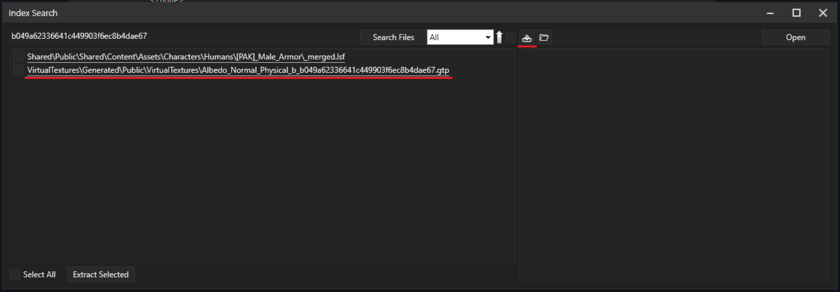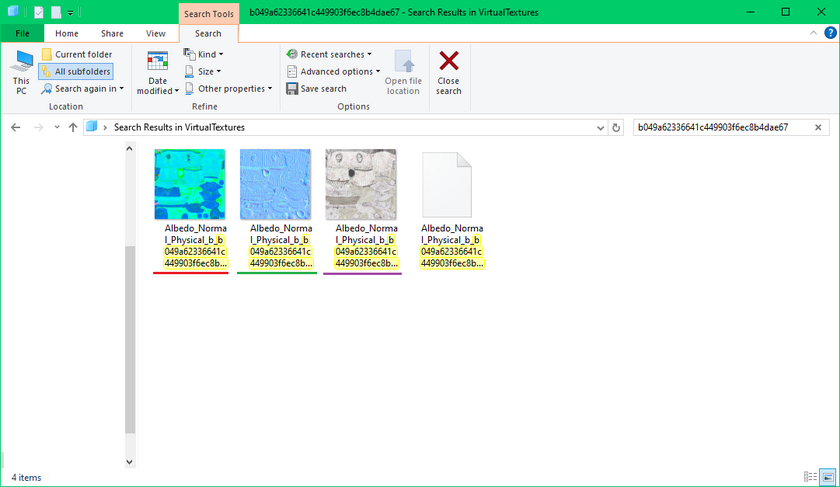Modding:How To Find A Virtual Texture: Difference between revisions
No edit summary |
No edit summary |
||
| Line 16: | Line 16: | ||
Put the name (or the NPC's name, to lead you to their CharacterVisuals entry) in the modder's multitool index search. This should lead you to its entry in the english.loca file. | Put the name (or the NPC's name, to lead you to their CharacterVisuals entry) in the modder's multitool index search. This should lead you to its entry in the english.loca file. | ||
Take the handle (a handle is h[string of numbers], similar to an UUID) and search that. | Take the handle (a handle is h[string of numbers], similar to an UUID) and search that. For example, The Deathstalker Mantle's handle is ''hb7ee75e7g15f1g42a7gacf3gafe7628d8b10''. | ||
This should lead you to the ''roottemplate'' of the item. (if it doesnt have one in the roottemplate, it's in the parenttemplate's file instead) | This should lead you to the ''roottemplate'' of the item. (if it doesnt have one in the roottemplate, it's in the parenttemplate's file instead) | ||
You can then find its mesh mapkey. Search that and you should find the meshes lsx entry. | You can then find its mesh mapkey. Search that and you should find the meshes lsx entry, which will lead you to the mesh name. For example, The Deathstalker Mantle's mesh name is ''UNI_DarkUrge_Bhaal_Cloak''. | ||
=== Finding the GTexFileName with the mesh name === | === Finding the GTexFileName with the mesh name === | ||
| Line 29: | Line 29: | ||
We like ''''HUM_M_ARM_Bandit_C_Body'''<nowiki/>' so we search this in the multitool. | We like ''''HUM_M_ARM_Bandit_C_Body'''<nowiki/>' so we search this in the multitool. | ||
It has an entry in '''Shared\Public\Shared\Content\Assets\Characters\Humans\[PAK]_Male_Armor\_merged.lsf''<nowiki/>' so we click | It has an entry in '''Shared\Public\Shared\Content\Assets\Characters\Humans\[PAK]_Male_Armor\_merged.lsf''<nowiki/>' ''''' so we click ''convert & open'' for that. | ||
We CTRL+F '''HUM_M_ARM_Bandit_C_Body''' and find a mesh entry for it. | We CTRL+F '''HUM_M_ARM_Bandit_C_Body''' and find a mesh entry for it. | ||
Revision as of 19:02, 6 January 2024
A virtual texture is essentially a digital box that BG3 uses to store textures in so they load quicker. This is good for the game's performance, but not so good if you want to extract and edit them. So here is how to extract them.
This tutorial requires Modder's Multitool, LSLib v19 and a knowledge of how to find things with the multitool.
How to find the mesh name
You can skip this step if you know the mesh name. The wiki has many item pages with the File names included. The Deathstalker Mantle, for example.
First thing you need to find the item is its name - the exact item name it has. For example, 'The Deathstalker Mantle'.
Put the name (or the NPC's name, to lead you to their CharacterVisuals entry) in the modder's multitool index search. This should lead you to its entry in the english.loca file.
Take the handle (a handle is h[string of numbers], similar to an UUID) and search that. For example, The Deathstalker Mantle's handle is hb7ee75e7g15f1g42a7gacf3gafe7628d8b10.
This should lead you to the roottemplate of the item. (if it doesnt have one in the roottemplate, it's in the parenttemplate's file instead)
You can then find its mesh mapkey. Search that and you should find the meshes lsx entry, which will lead you to the mesh name. For example, The Deathstalker Mantle's mesh name is UNI_DarkUrge_Bhaal_Cloak.
Finding the GTexFileName with the mesh name
You will need to find the GTexFileName in order to find the correct virtual texture to extract. So search the mesh name in the search index in Multitool.
You may need to append it with HUM_M_ instead of whatever race you are looking for, as most of the universal gtex are under HUM M meshes. The same applies with HUM F and female specific meshes. Some meshes also share textures with other versions of the mesh, so you may need to remove the _a or _broken (for example) appendage if you aren't getting any matches.
We like 'HUM_M_ARM_Bandit_C_Body' so we search this in the multitool.
It has an entry in Shared\Public\Shared\Content\Assets\Characters\Humans\[PAK]_Male_Armor\_merged.lsf' so we click convert & open for that.
We CTRL+F HUM_M_ARM_Bandit_C_Body and find a mesh entry for it.
<node id="Resource"> <attribute id="AttachBone" type="FixedString" value="" /> <attribute id="AttachmentSkeletonResource" type="FixedString" value="" /> <attribute id="BlueprintInstanceResourceID" type="FixedString" value="" /> <attribute id="BoundsMax" type="fvec3" value="0.5363549 1.713599 0.176041" /> <attribute id="BoundsMin" type="fvec3" value="-0.5405712 0.6668076 -0.219203" /> <attribute id="ClothColliderResourceID" type="FixedString" value="" /> <attribute id="HairPresetResourceId" type="FixedString" value="" /> <attribute id="HairType" type="uint8" value="0" /> <attribute id="ID" type="FixedString" value="8e7bcc4a-2b65-d704-1cf0-a1a3bc8b8bd3" /> <attribute id="MaterialType" type="uint8" value="44" /> <attribute id="Name" type="LSString" value="HUM_M_ARM_Bandit_C_Body" /> (bolded for importance!)
We scroll down to the end of the mesh entry and find the Objects.
<attribute id="LOD" type="uint8" value="0" /> <attribute id="MaterialID" type="FixedString" value="57a6fd6e-c00d-60eb-5e52-31560b95332b" /> <attribute id="ObjectID" type="FixedString" value="HUM_M_ARM_Bandit_C_Body.HUM_M_ARM_Bandit_C_Body_Mesh.0" /> </node>
This material ID is what we need. We scroll back up to the very start of the _merged.lsf (materials are usually near the top) and ctrl+f for that.
We find
<node id="Resource">
<attribute id="DiffusionProfileUUID" type="FixedString" value="" />
<attribute id="ID" type="FixedString" value="57a6fd6e-c00d-60eb-5e52-31560b95332b" />
<attribute id="MaterialType" type="uint8" value="22" />
<attribute id="Name" type="LSString" value="HUM_M_ARM_Bandit_A_Body" />
[material continues, cut for length]
We scroll down to the end of the material, past the vector parameters and we find:
<node id="VirtualTextureParameters"> <attribute id="Enabled" type="bool" value="True" /> <attribute id="ExportAsPreset" type="bool" value="True" /> <attribute id="GroupName" type="FixedString" value="Texture Map" /> <attribute id="ID" type="FixedString" value="d53fa1a1-aa8e-2564-1077-42f6c36086c5" /> <attribute id="Index" type="int32" value="0" /> <attribute id="ParameterName" type="FixedString" value="virtualtexture" /> </node>
So we search d53fa1a1-aa8e-2564-1077-42f6c36086c5. Luckily for us, it is in the same file. (If it isn't you may need to search the multitool with it.)
<node id="Resource"> <attribute id="GTexFileName" type="FixedString" value="b049a62336641c449903f6ec8b4dae67" /> <attribute id="ID" type="FixedString" value="d53fa1a1-aa8e-2564-1077-42f6c36086c5" /> <attribute id="Localized" type="bool" value="False" /> <attribute id="Name" type="LSString" value="HUM_M_ARM_Bandit_A_Body" /> <attribute id="Prefetch" type="bool" value="False" /> <attribute id="PrefetchMipLevel" type="int8" value="-1" /> <attribute id="ReferencedColorSpaces" type="uint32" value="6" /> <attribute id="SourceFile" type="LSString" value="" /> <attribute id="VirtualTextureLayerConfig" type="uint32" value="3" /> <attribute id="_OriginalFileVersion_" type="int64" value="144115205255725056" /> </node>
b049a62336641c449903f6ec8b4dae67 is the correct string. Now you can extract it from the virtual textures.
And we do see that it shares a texture with the other bandit models- it is the part under the armour. We will need to go back and extract the armour and accessories separately by looking at the materials under the different mesh chunks listed in the mesh entry.
Unpacking using Multitool
Search b049a62336641c449903f6ec8b4dae67 in the multitool. Select the file inside VirtualTextures and click on the Extract file icon.

Now go to your Multitool/UnpackedData/VirtualTextures folder and search for b049a62336641c449903f6ec8b4dae67.
Here are the three texture files you will need, in .dds format. The red underlined one is the PM (Physical Map), the green underlined one is the NM (Normal Map), and the purple underlined one is the (BM) Base Map. The PM is usually brighter colors, the NM is usually almost all blue, and the BM is usually very light with a sort of beige tone.
Lslib
Lslib v19 also lets you unpack just specific gtp files via the gtex name.
Alternately you can just unpack all the VT into one folder and just search with Windows Search, but this is extremely file heavy and not recommended.
Remember Mipmaps
The extracting process strips the virtual textures of their mipmaps! Even if you are not editing some maps, you need to import them into GIMP(or any similar program) and resave with mipmaps to generate new ones if you are including them with your mod. See here for save settings.
